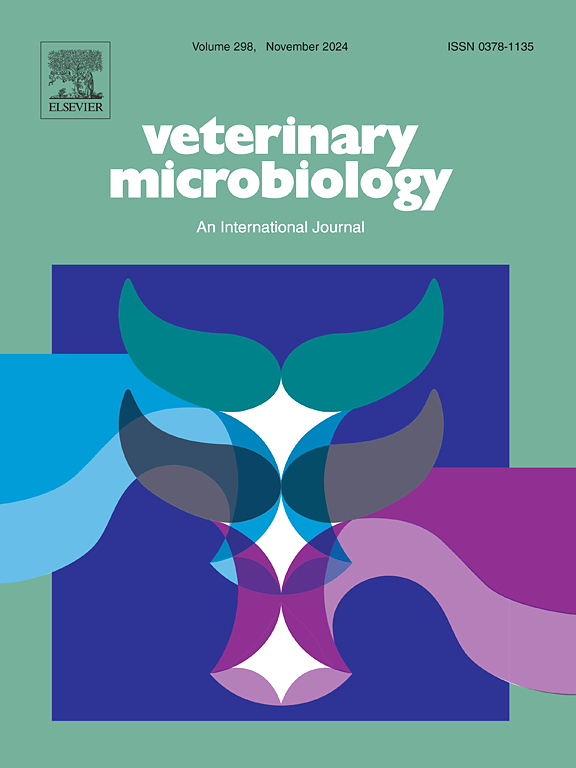The mRNA vaccine expressing fused structural protein of PRRSV protects piglets against PRRSV challenge
IF 2.4
2区 农林科学
Q3 MICROBIOLOGY
引用次数: 0
Abstract
The swine industry experiences substantial economic losses annually due to the porcine reproductive and respiratory syndrome virus (PRRSV). The limited protective efficacy of existing commercial vaccines against epidemic PRRSV underscores the urgent need for innovative solutions. The mRNA vaccines, which elicit robust immune responses, have emerged as a promising avenue in vaccine development. In this study, two distinct mRNA vaccines were engineered: one encoding the full-length GP5 and M proteins (GP5-M), and the other encoding the full-length N protein along with epitope peptide segments of the M and E proteins (NMEpep). Our findings indicate that, compared with NMEpep, piglets immunized with the GP5-M mRNA vaccine produced specific antibodies, exhibited elevated levels of PRRSV-specific IFN-γ, and demonstrated effective activation of CD4+ and CD8+ T cells as well as CD21+ B cells. Furthermore, the GP5-M vaccine conferred protective efficacy against HP-PRRSV challenge, evidenced by the mitigation of clinical symptoms, reduction in viral loads, and alleviation of tissue damage. In conclusion, this study presents a promising candidate vaccine for addressing epidemic PRRSV and establishes the GP5-M mRNA vaccine as a viable platform for the development of next-generation PRRSV vaccines.
表达PRRSV融合结构蛋白的mRNA疫苗对仔猪PRRSV侵袭具有保护作用
由于猪繁殖与呼吸综合征病毒(PRRSV),养猪业每年遭受巨大的经济损失。现有商业疫苗对流行性PRRSV的保护效力有限,这突出表明迫切需要创新的解决方案。mRNA疫苗可引起强烈的免疫反应,已成为疫苗开发的一个有希望的途径。在本研究中,设计了两种不同的mRNA疫苗:一种编码全长GP5和M蛋白(GP5-M),另一种编码全长N蛋白以及M和E蛋白的表位肽段(NMEpep)。我们的研究结果表明,与NMEpep相比,GP5-M mRNA疫苗免疫仔猪产生特异性抗体,prrsv特异性IFN-γ水平升高,并有效激活CD4+和CD8+ T细胞以及CD21+ B细胞。此外,GP5-M疫苗对HP-PRRSV攻击具有保护作用,这可以通过减轻临床症状、减少病毒载量和减轻组织损伤来证明。总之,本研究提出了一种有前景的应对流行性PRRSV的候选疫苗,并建立了GP5-M mRNA疫苗作为开发下一代PRRSV疫苗的可行平台。
本文章由计算机程序翻译,如有差异,请以英文原文为准。
求助全文
约1分钟内获得全文
求助全文
来源期刊

Veterinary microbiology
农林科学-兽医学
CiteScore
5.90
自引率
6.10%
发文量
221
审稿时长
52 days
期刊介绍:
Veterinary Microbiology is concerned with microbial (bacterial, fungal, viral) diseases of domesticated vertebrate animals (livestock, companion animals, fur-bearing animals, game, poultry, fish) that supply food, other useful products or companionship. In addition, Microbial diseases of wild animals living in captivity, or as members of the feral fauna will also be considered if the infections are of interest because of their interrelation with humans (zoonoses) and/or domestic animals. Studies of antimicrobial resistance are also included, provided that the results represent a substantial advance in knowledge. Authors are strongly encouraged to read - prior to submission - the Editorials (''Scope or cope'' and ''Scope or cope II'') published previously in the journal. The Editors reserve the right to suggest submission to another journal for those papers which they feel would be more appropriate for consideration by that journal.
Original research papers of high quality and novelty on aspects of control, host response, molecular biology, pathogenesis, prevention, and treatment of microbial diseases of animals are published. Papers dealing primarily with immunology, epidemiology, molecular biology and antiviral or microbial agents will only be considered if they demonstrate a clear impact on a disease. Papers focusing solely on diagnostic techniques (such as another PCR protocol or ELISA) will not be published - focus should be on a microorganism and not on a particular technique. Papers only reporting microbial sequences, transcriptomics data, or proteomics data will not be considered unless the results represent a substantial advance in knowledge.
Drug trial papers will be considered if they have general application or significance. Papers on the identification of microorganisms will also be considered, but detailed taxonomic studies do not fall within the scope of the journal. Case reports will not be published, unless they have general application or contain novel aspects. Papers of geographically limited interest, which repeat what had been established elsewhere will not be considered. The readership of the journal is global.
 求助内容:
求助内容: 应助结果提醒方式:
应助结果提醒方式:


